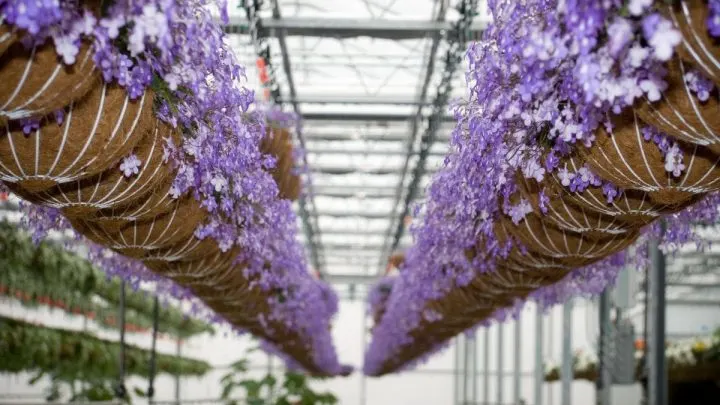The time has come. You want to fill that empty space near the door or you just want to hang some new flowers on the wall. Say no more. You’ve come to the right place. What do you think about hanging purple flowers?
If you want to achieve that wow vigorous effect with your plants, hanging purple flowers are the best for that effect.
We all want to have plants like that in our house. Their perfect lengths dropping from the wall just wakes a huge interest in all of us.
They don’t cost much, even when you deliver them, and they create that perfect image of our living room or any other room you put them in.
Today, we will talk about the wonderful 11 purple hanging flower varieties. By the end of this article, you will want one of them so badly!
What Are The Best Hanging Purple Flowers?
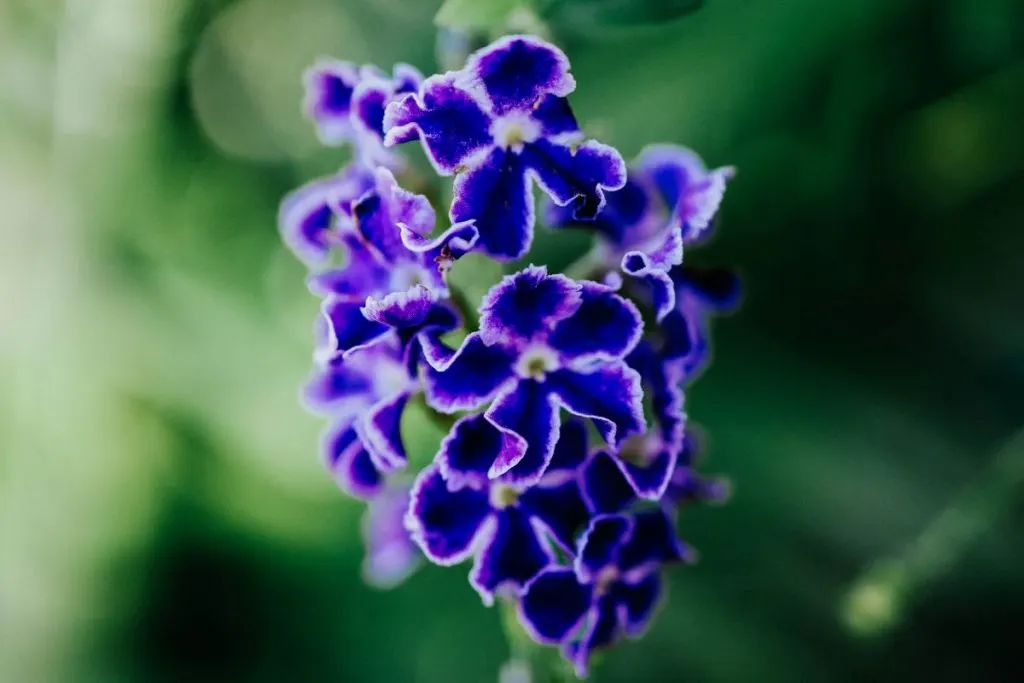
There is no right or correct answer to this question. It can depend on the country/countries you’re asking this question in or it can be a subjective opinion.
We will talk about many plants today, and 80% of you will have a different opinion about the “best purple flower.”
However, based on research and statistics on purple flower sales, the “Verbena” flower along with “Wisteria” makes the best purple flower for your home.
Why Choose Hanging Plants For Your Home?
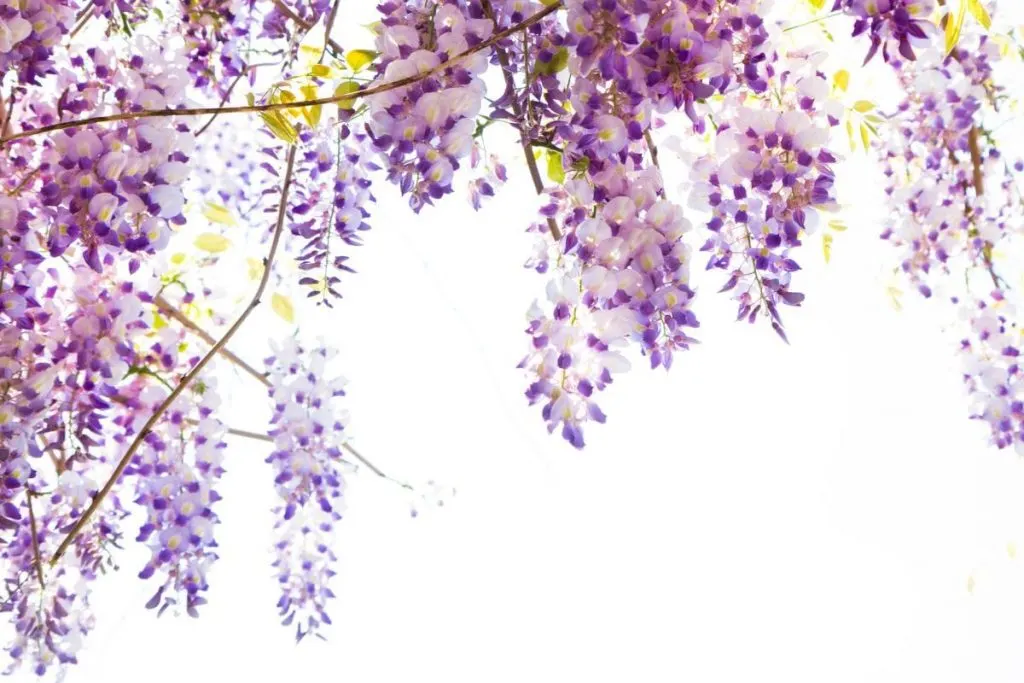
Before getting some hanging flowers you will surely ask yourself this question. Why should you choose hanging plants instead of a regular good old poot on the desk or floor?
If you are limited by space, we suggest lifting the plants off the floor. And placing them in the form of wall systems, vertical gardens, or hanging them from the ceiling in neutral jars to make the plants stand out and create a fun, fulfilling, and dynamic interior.
Place larger plants individually and smaller ones in groups to get a composition of beautiful colors and textures.
If drilling walls or ceilings is out of the question, let climbing plants slide down bookshelves or climb walls to create a small jungle in the middle of your home or office.
Hanging Baskets Here We Come
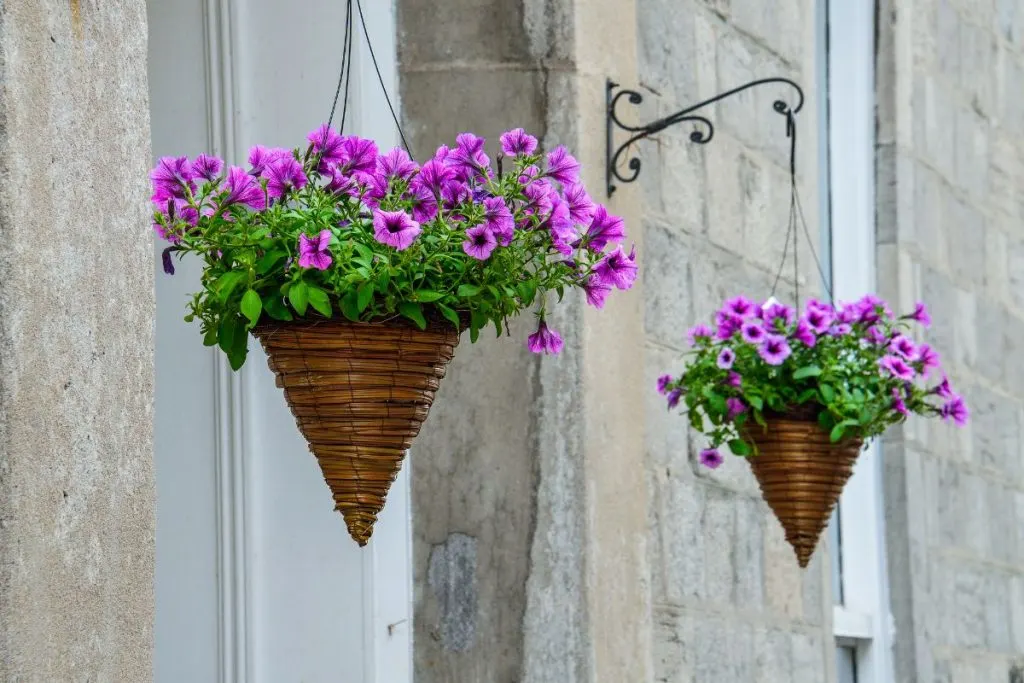
If you’ve decided that the right time has come to bring some purple flowers into your home, then keep reading. Not yellow, not pink, no red flowers, today, we’re going to dedicate this article to 11 amazing purple flowers. It would be too long if we listed all over favorites, like the purple queen plant. But our top 11 will do the job.
And guess what, all of them are hanging flowers so it is the right time to buy some hanging baskets as well. The search stops now because we’re about to tell you everything about them!
1. Learn About Chinese Wisteria (Floribunda)
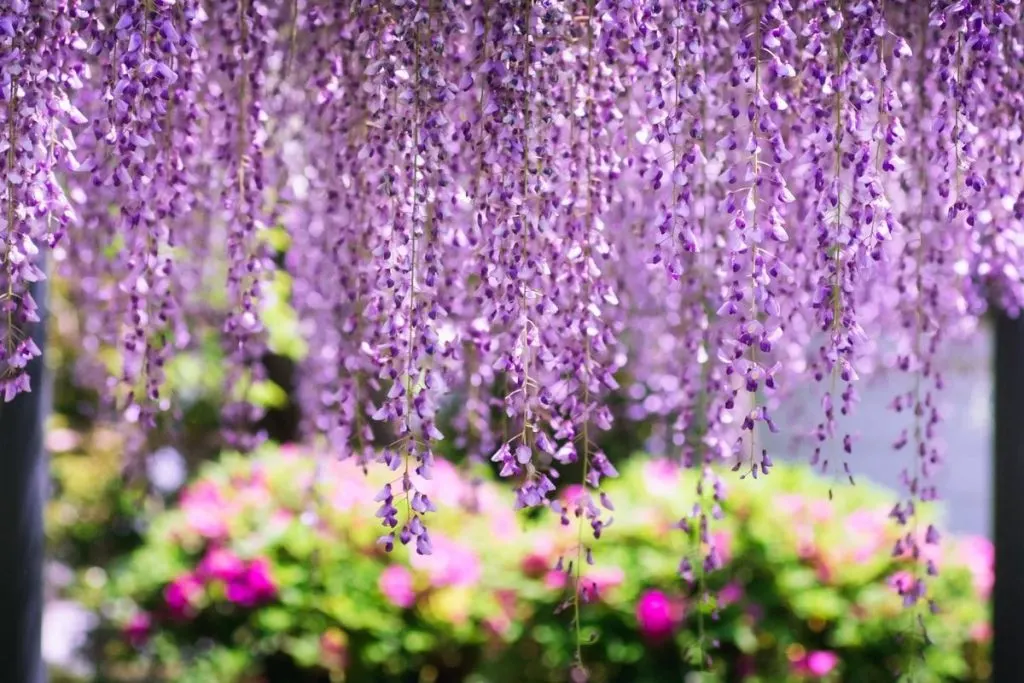
Chinese wisteria (wisteria Sinensis) is a woody vine belonging to the legume family. It blooms very beautifully, forming large clusters of purple, crimson or white flowers.
– Some plant varieties can tolerate low temperatures. Therefore, especially thermophilic varieties are growing as indoor bonsai trees.
– This is the most resistant wisteria of all existing species. It can withstand temperatures up to 32 F. So it is growing not only in the southern parts but also in the middle lane. Its flowers are purple-blue, like Blue Sapphire, but much larger.
– It grows well in sunny areas and in partial shade. Since this vine loves the sun, daylight for it should last 5-6 hours. At the same time, hysteria loves not only light but also heat, it needs protection from strong winds and cold.
– Wisteria propagation is with seeds and vegetatively. But consider that the first option is not the most reliable. Seed germination is only about 25%.
In addition, many gardeners notice that with this method of propagation the plant blooms upwards and cannot bloom at all. Therefore, the best option is to buy hysterics with a well-developed and intact root system.
– Wisteria grows in the southern parts, does not like drought, but also needs moderate watering. This means that it is enough to ensure that the soil near its roots does not dry out.
Of course, when the bud comes, it is necessary to further moisten the soil if the spring is dry. This will prevent the buds from releasing. In the hot season, the recommendation is to spray the plant.
– Wisteria, regardless of variety, gives color only if properly pruned. The flowers appear only on shoots that have formed in previous years. Young shoots are cut in the spring, so it does not affect the appearance of flowering vines.
2. Purple Wisteria As Perfect Hanging Purple Flowers
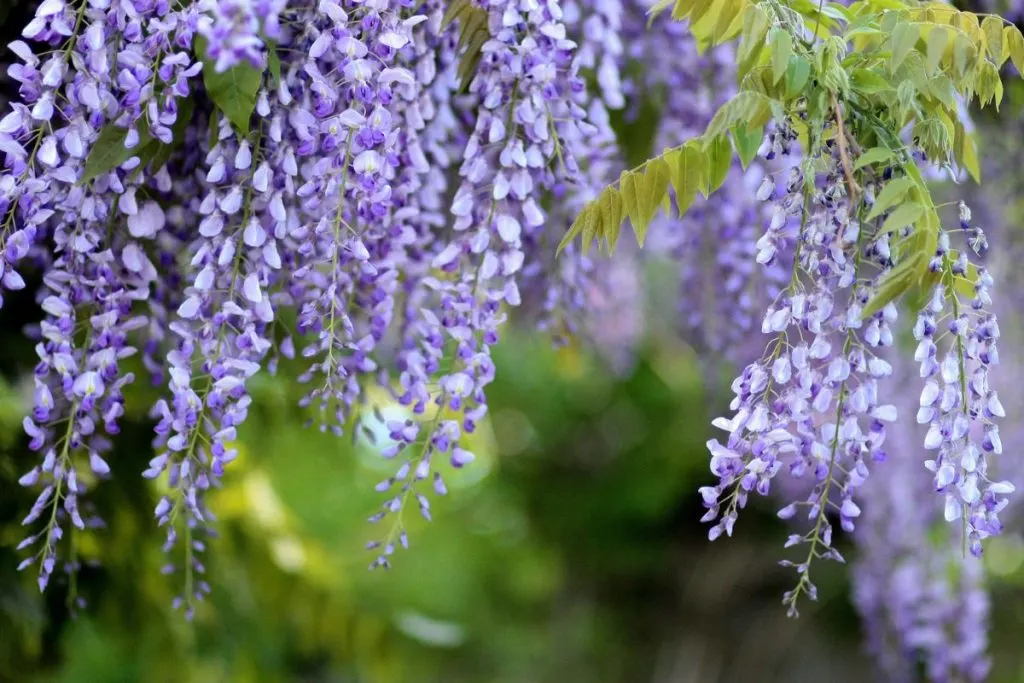
Purple Wisteria is a richly flowering woody climber, much more popular than you might think. One of the most famous fictional streets in the world, Wisteria Lane, was named after this perennial. It is the street where the heroines of the “Housewives” series lived.
– Wisteria is an outdoor plant that needs a lot of light and thrives best in full sun. Place it in a basket in a position, so that it protects the Wisteria from the wind. Plant it in loose soil always. This type doesn’t like mixed soils.
– When it blooms first, it might seem pink or violet at first, but this is one of the most famous purple hanging flowers. With its amazing look, it has the possibility to enable background and simply leave you speechless.
– Wisteria flower buds develop near the base of growth of the previous year so that by pruning in early spring the flower comes to the fore. In the middle of summer, prune it again by a third of the grown part in the fall.
Be careful with the stroke width since it can damage the plant. You should not see the clip-path, but hey, not all of us are experienced gardeners.
– Grow it from seeds on the fruit of the pod, but then the first flowering can take more than 10 years. Plant the cuttings in compost and spray the leaves regularly, take care that the compost does not dry out.
– Cuttings taken in early spring can be planted outdoors in the fall. And those later can be transplanted in the late spring, or early summer, but must overwinter indoors. Water it as in Chinese wisteria.
3. Find Out More About Hanging Purple Flowers Fuchsia
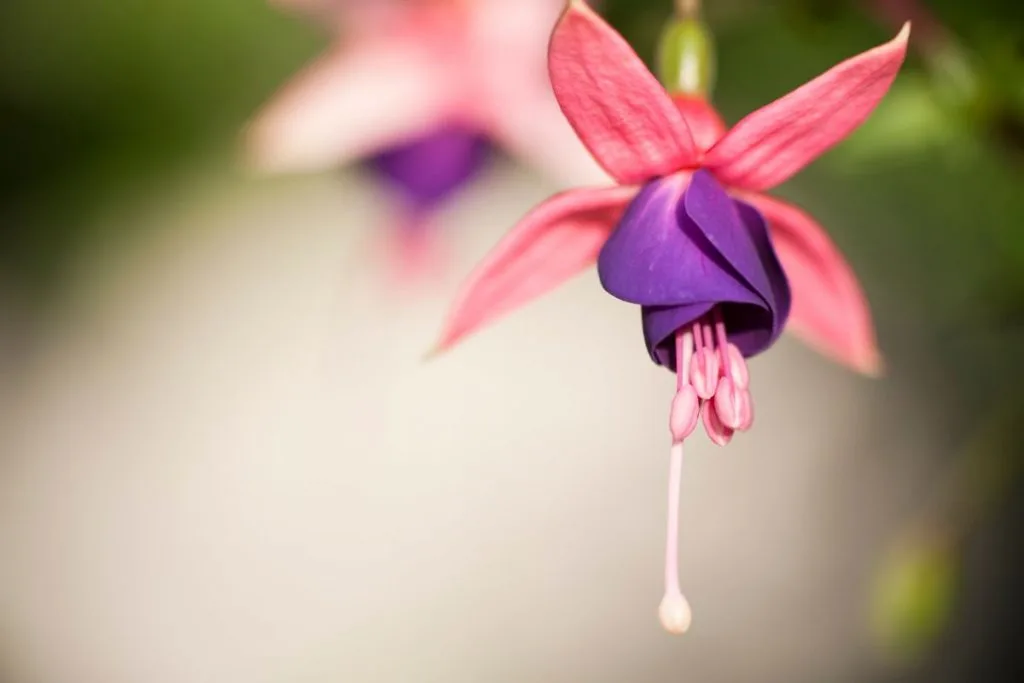
Fuchsia (Fuchsia x hybrida) is an ornamental plant that is most widespread in subtropical America and has more than 840 species. It was named after the botanist Leonhart Fuchs who worked on discovering new species. It is primarily grown for its beautiful ornamental flowers.
– Fuchsia loves moist soil. Therefore watering the plant should get special attention. Water the plant every day, but it is also necessary to check the soil. Water it only if the surface soil is dry.
– Fuchsias planted in the garden are fed from spring to late summer, while those that grow indoors are fed in late summer. For fertilization of houseplants or balcony plants use liquid fertilizer with the addition of nitrogen and potassium.
– Fuchsia propagate from seeds and cuttings. The seed is small and ripens inside the fruit and berries. That is why it needs to be clean of flesh and dried well. It is best to plant stratified seeds because they have higher germination.
– Soils mixed with sand suit her. For its own needs, fuchsia is most often bought as a ready-made seedling with an already developed root that is ready for transplanting.
– Planting from seed is very rare, but it is possible to grow it that way. The seeds have low germination. So leave them soak overnight. Sow it in a mixture of earth and sand, water it, and cover it with foil.
– In order for the plant to develop properly, it is necessary to thin the plantation (stems). Manually do the thinning, while the soil is moist. So that you can remove the root completely.
4. Is Petunia A Good Choice For You As Hanging Purple Flowers?
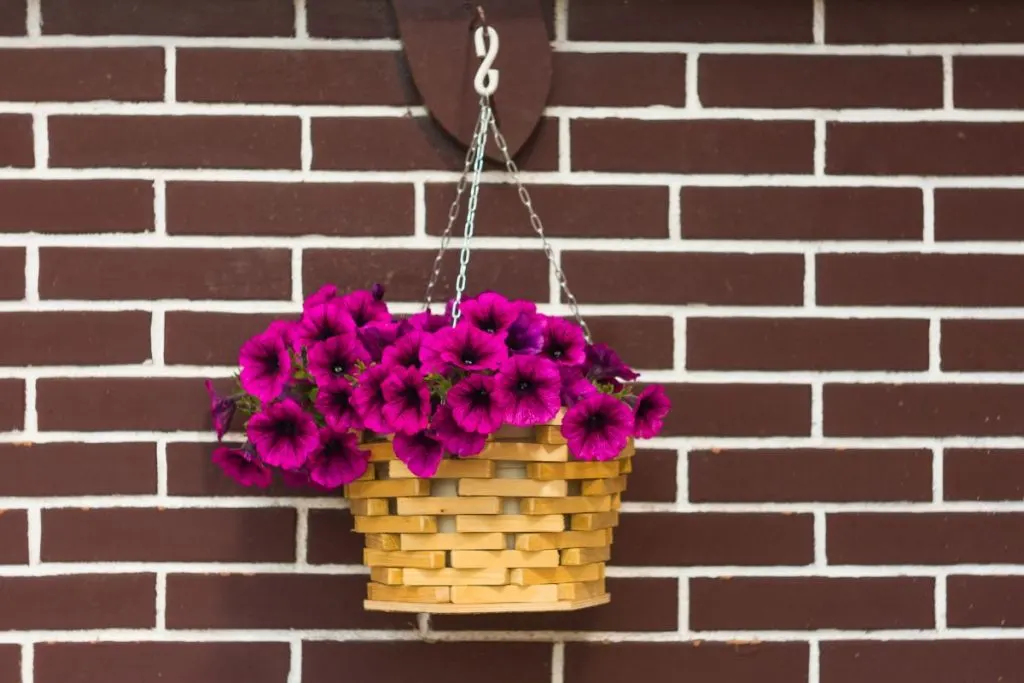
Petunia is a flower that captivates with its beautiful appearance and specific scent. If you are thinking of getting petunias yourself, we bring you tips for growing and maintaining them.
– Petunia is an annual plant from the Solanaceae family. It is native to South America, from where it soon spread to the rest of the world. This is a flower that needs large amounts of sunlight. Location is therefore very important for this plant.
– It thrives best in a direct judge or in a semi-shady place, and it is also very important that it is watered regularly. Namely, it does not tolerate excessive heat or drought, so it is best to water it daily.
– Plant petunias in February and March indoors. As soon as the first leaves sprout, we transplant the petunia into a larger pot, which we can then take out on the balcony or keep in the living room.
It is good to shape the seedling, to be more precise, to tear off the top in order to promote branching. When the seedling is compacted, we can remove only a few inches.
– Petunias need fertilization with nutritious humus rich in iron and pruning. Pruning removes faded flowers and thus further enhances flowering.
5. Perks Of Having A Heliotrope
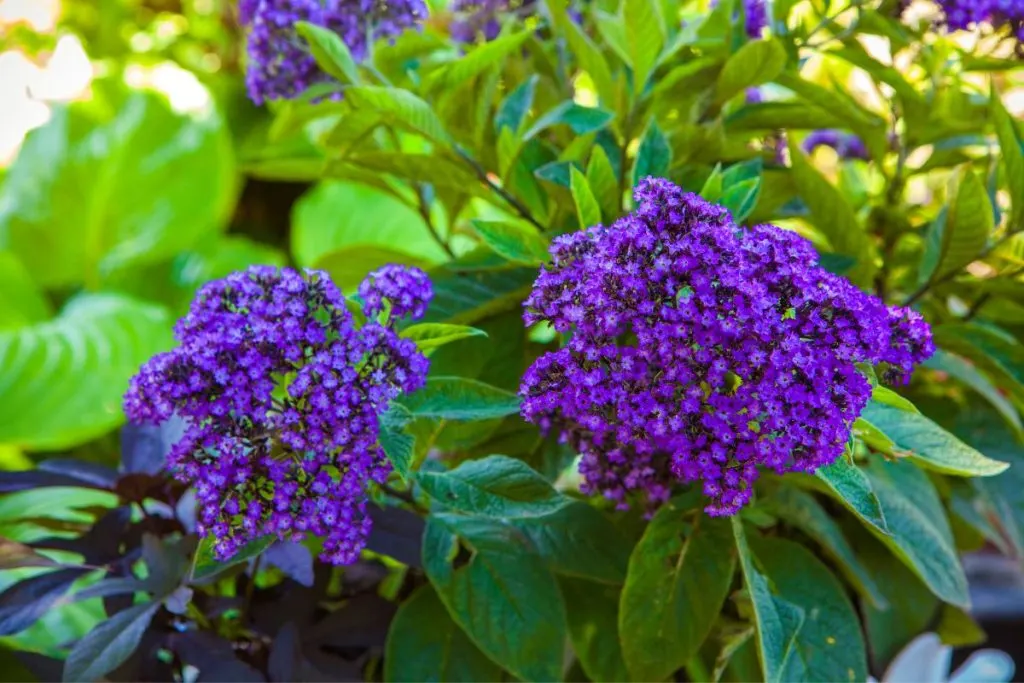
Heliotrope leaves are ovate, alternate, dark green, pubescent, wavy, or wrinkled, on short stalks. Small fragrant flowers contain essential oils. It’s a great plant for a yard fence with style.
– For those who want to know how to grow heliotrope from seed, it is important to remember that heliotrope seed is better to buy in specialty stores.
– In the open ground, plant heliotrope in early June, when the last night frosts have passed. For planting, choose a sunny place with fertile, loose, permeable soil, rich in humus.
– Growing heliotrope flowers requires, above all, adequate soil moisture. Manure and leaf humus are well added to the heliotrope. Transfer the plants carefully from the pot into the hole. Cover the hole with garden soil, squeez it around the seedling, and water it.
– Watering heliotrope is carried out as needed, in dry summers it is necessary to water more often. After watering you need to carefully loosen the soil between the bushes and remove weeds.
Like, by the way, watering. Feed the heliotrope full of complex fertilizer every two weeks until active flowering begins.
– Spider mites, aphids, and whiteflies damage the heliotrope. If the problem cannot be removed immediately, actellic treatment should be repeated after a week. Sometimes the plant gets gray mold.
6. Lilac Is Always IN
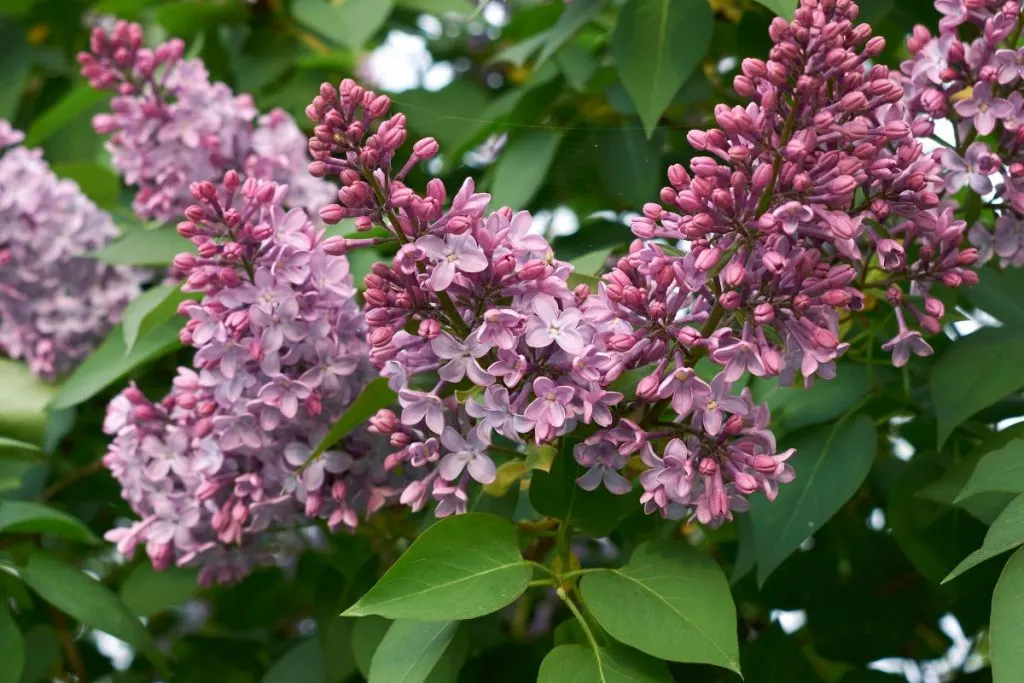
Beautiful lilac flowers (Syringa vulgaris) are in use for creation of bouquets and decorate gardens and landscapes. Their unique form makes them so wanted.
That is why you can rarely be on time in-store to buy some. Their flowers have so many details that you simply just want to hang them on the wall to watch them as images lol.
– Lilac can be propagated by seeds, cuttings in spring, or buds in summer. We plant it as a single tree or as an ornamental hedge, in the fall or early spring. Suitable for a sunny place, although it can grow in semi-shade. The soil should be fertile, moist, and slightly alkaline.
– Sunny or semi-sunny places and nutritious, well-permeable soil with a slightly alkaline environment are best for growing lilacs. If the soil contains too much nitrogen, lilac will bloom less.
– To encourage flowering, in the spring you need to fertilize the plant with a fertilizer rich in phosphorus. Fertilization with a complex fertilizer is repeated after flowering. Unpruned lilacs usually bloom every year, and an old tree gives more flowers if not pruned.
– Be careful when pruning because lilac on young branches produces flowers only after three years. If you want to rejuvenate lilac, you only need to remove one-third of the old branches each year.
– Over time, freckles appear, and the tissue at that site dies. If young leaves that have not yet reached the right size are infected, they remain small and deformed, and other parts of the plant dry out and die. Control powdery mildew by spraying with one of the fungicides.
– For many years now many people believe that lilac is a toxic plant, but no scientific analysis has confirmed that it is really poisonous to humans. Lilac flowers are edible and can be used in cakes or cocktails.
7. Here Comes Aster

Aster is a genus of Genus that includes over 200 different species, with extremely variable sizes, shapes, flowers, and resistance to climatic conditions. There are perennial species and annuals.
– The aster needs light and well-drained soil. PH should be neutral or slightly alkaline, rocky type. It does not tolerate water stagnation.
– Choose a sunny place, even if in some cases, in the warmest areas, it can live even in partial shade. In spring and summer, regularly water the plants. The soil must always remain moist to allow adequate growth.
– This is especially true for potted species. They survive well in the rain. Fertilize in spring and summer, every 20 days or so. This will ensure abundant flowering.
– Cut the plants a few inches above the ground, before the temperature drops. In general, we adjust to the choice of the period as soon as flowering is over. Mulching protects the soil.
– If you plan to propagate the plant, especially in September, you must act every 3 years to prevent them from being lost. We always continue in the phase of vegetative dormancy, ie before winter or in spring, but always before recovery.
– Aster is susceptible to some parasites and fungi. Powdery mildew often affect asters. It is recognizable by the appearance of white and furrowed spots.
8. Who’s Up For Some Morning Glory?
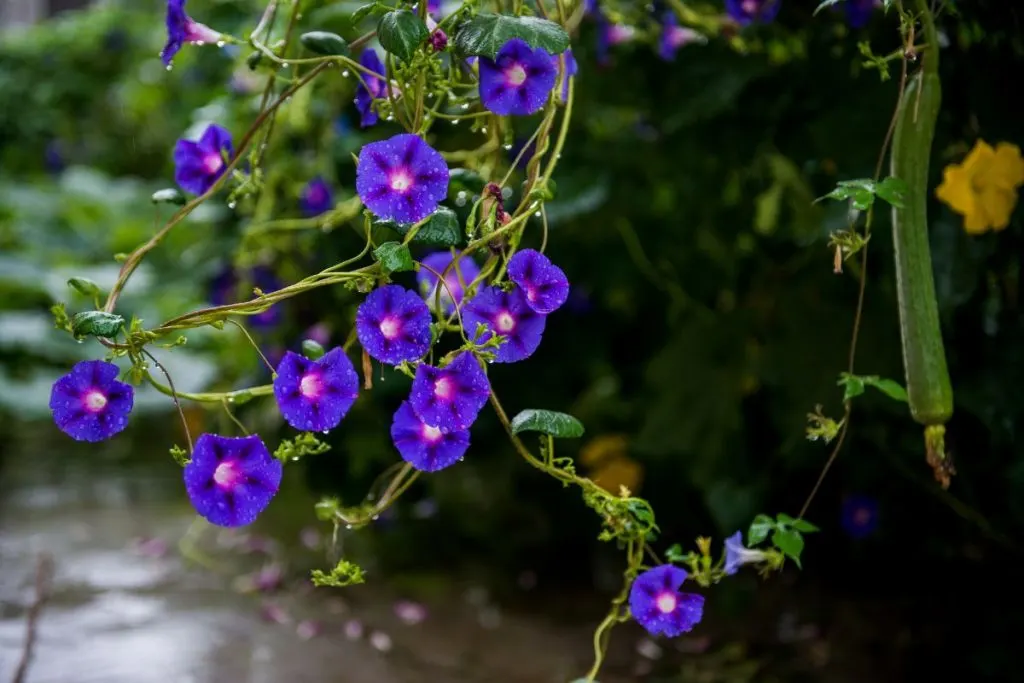
The name “morning glory” comes from two Greek words: “ips” – worm and “homoios” – similar, or “worm-shaped”, and this definition refers to the perennial rhizome of the genus morning glory.
– Propagate the morning glory with seeds, which remain viable for three to four years after harvest. Sown the Ipomoea seeds in the substrate in mid-May but previously soak them for one day in water of 60-65 F for swelling. If the seeds do not swell, pierce their shell with a needle and re-soak.
– When the seedlings grow to a height of 9 inches, tie a string at the base of the sprout. On the other end, a growing hunter will climb along with this guide.
As the seedlings grow, reload them once or twice into a large container so as not to damage or expose the roots. If you want more side shoots, you need to tighten the seedlings.
– Carry out planting in the open ground of cultivated seedlings Ipomoee in late May or early June. At this point, the soil has already warmed up and you can not be afraid of night frosts, which could destroy the young liana.
– It is easy to take care of the morning glory: water regularly but moderately so that water does not stagnate at the roots: from May to August – without waiting for the soil to dry and from September – after the soil dries.
– Fertilize during the period of active growth every 2-3 weeks with fertilizer for ornamental flowering plants or for cactus.
9. Don’t Forget Pansy
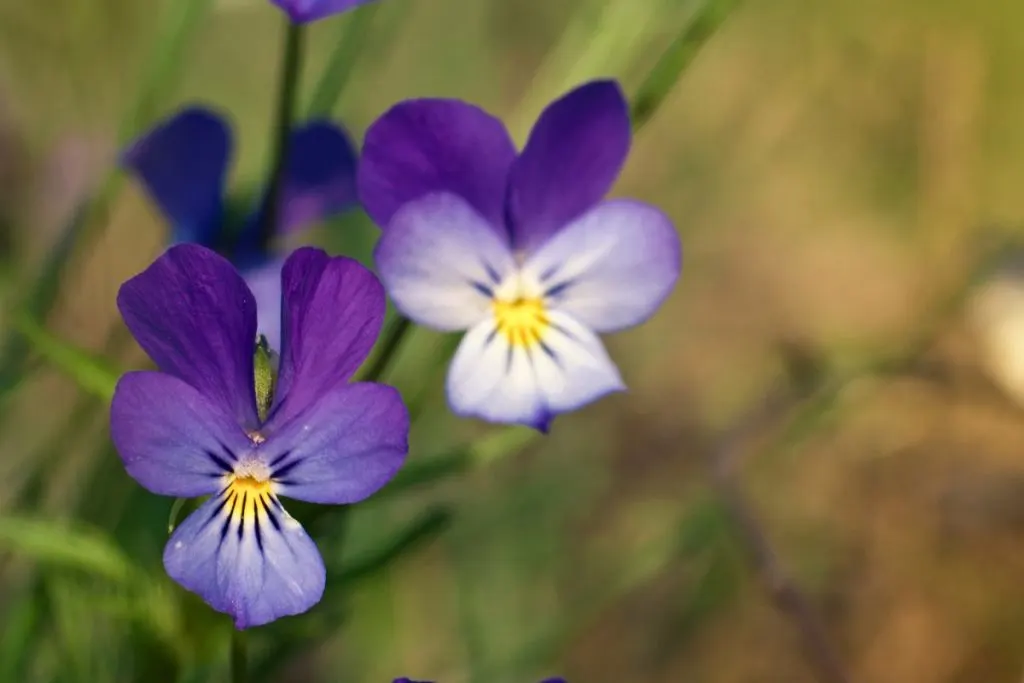
Pansy (Viola tricolor) is a well-known meadow plant from the Violaceae family. Folk names for this flower are St. John’s wort, orphan, field violet, and day and night.
The scent of these flowers is pleasant and not strong. The flowers and leaves are edible and in use to decorate food as raw or cooked.
– If they are propagated by cuttings, it is necessary to take them during May must have three nodes. Planting pansy is done in the well-prepared, light garden soil at a depth of 1 inch and at a distance of 10-12 inches. Cover the cuttings with damp newsprint that will retain moisture.
– Pansies are transplanted when they have individual pots when they have three leaves. Care needs to be continued and the plants need to be pinched after three weeks in the greenhouse to get a branched shrub that will give more twigs and flowers.
– The optimal time for spring planting of pansies in the garden is the end of February, while autumn planting is ideally done during October. When planting in flower pots, care should be taken to have openings in the bottom so that excess water can drain from the substrate.
– Pansies are easiest to propagate by seed. In this case, sown them in late June until mid-August. Follow the sowing by dipping and then transplanting. The soil should be rich in organic matter and permeable, so as not to retain water.
10. Verbena Is Still Popular
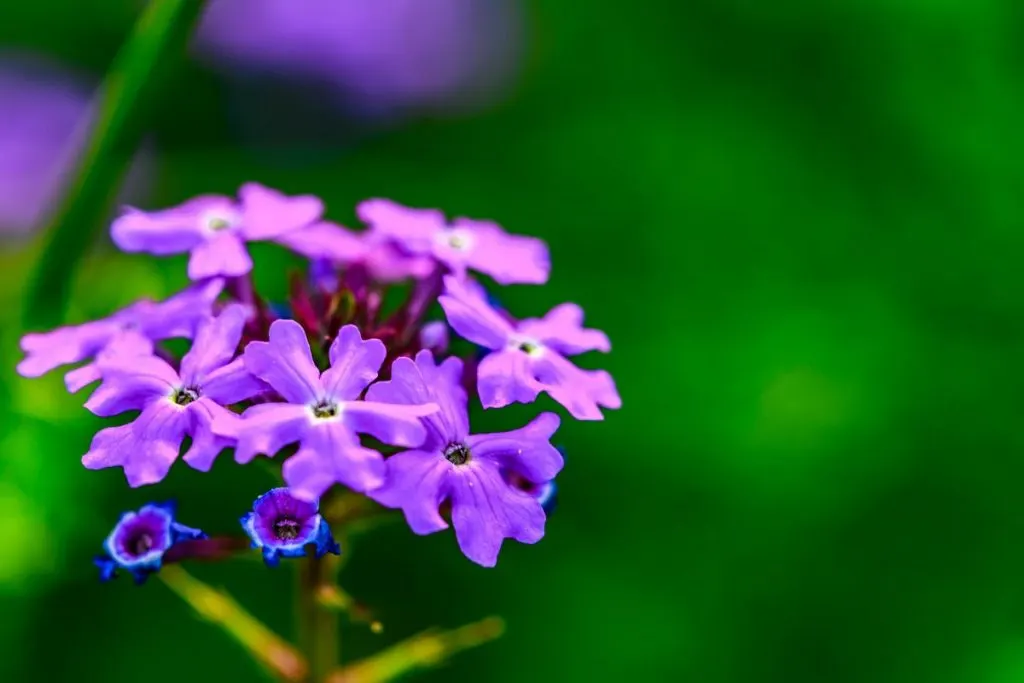
Verbena (Verbena Officinalis) belongs to the group of annual or biennial herbaceous plants of the Verbenaceae family. It originates from South America.
– It has bisexual flowers that come in lavender color, and their shape is similar to a trumpet. They are gathered at the top of the branches in branched spikes and are located in the axillary parts of the leaves.
– Verbena is sown outdoors during the spring months. Suitable for sunny or slightly shady areas. It tolerates dry and very hot periods well, during which its honey properties do not decrease. She won’t mind the occasional strong winds either. The soil for growing spores should be well-drained and loose.
– The plant requires moderate watering to grow well. Water it immediately after planting and until it starts to grow, and when it takes root at least once a week or as needed.
– Be careful not to overdo it as too wet and damp soil will not suit her. Before watering, make sure that the soil is dry enough and only then water it.
– There are no big requirements for fertilizer, but it will still bloom better if you fertilize it every other week. If you want to encourage bushy growth, when the young plants sprout two pairs of leaves, remove the top of the stem. If the verbena loses its shape, shorten the overgrown branches by two-thirds.
– Since it is usually an annual plant, it will need to be sown every season. Sowing of verbena is done in late February in pots or jars.
11. Bell Flowers For Your Home
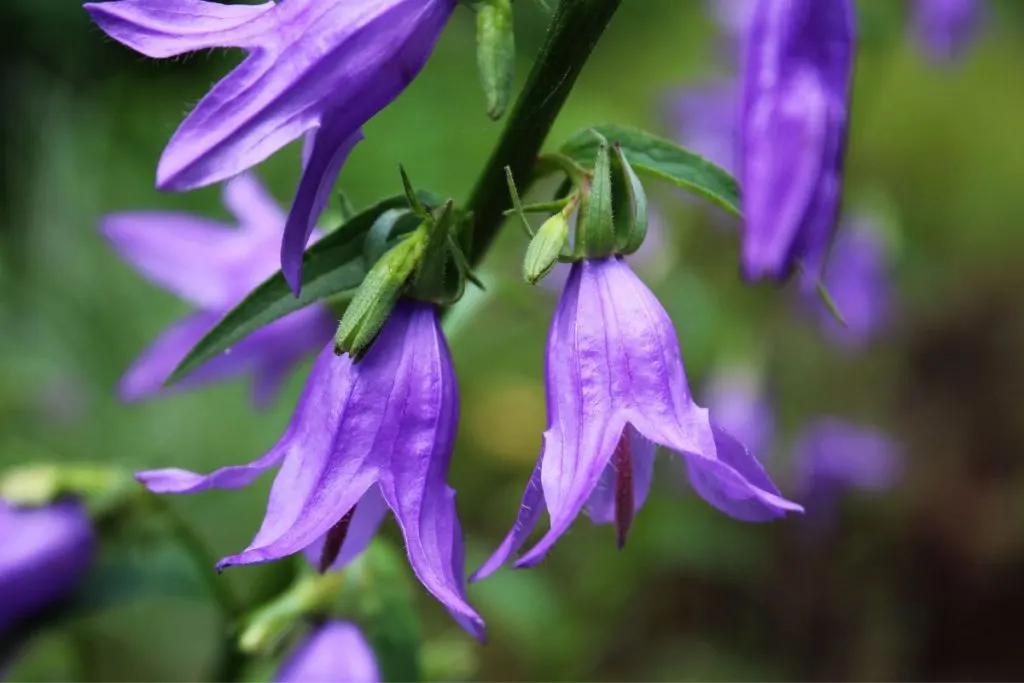
Bell flowers do not require prior preparation before sowing. They can be sown directly into the ground in May or before winter in October. But if you want them to bloom this year, plant them in March for seedlings.
– Because the seeds are very small, they are laid on a light, loose, permeable substrate, well moistened, and consisting of humus, turf, and coarse sand in a ratio of 3: 6: 1. It is not necessary to add fertilizer to the substrate.
– The seeds are lightly pressed to the ground, sprayed with water from a sprayer, and then covered with a film. They contain crops at a temperature of 60-65 F. Seedlings can appear in two or three weeks.
– In the open field bell seedlings are planted in late May or early June. Most bells are light-loving, shade-loving species grown in culture, literally few, and recognizable by the dark green color of the leaves. The bell does not like drafts.
– As for the soil, some species thrive on rocky, some on limestone, but most species prefer neutral or slightly alkaline well-drained loamy soils. Planting bells in the ground is carried out after its preliminary preparation.
For deep digging sand and humus are introduced into heavy soils and earthen soil and fertilizers into poor soils. Do not apply only fresh manure and peat, as this increases the risk of fungal diseases on plants.
– Growing bells is no different than growing any other garden flower – bells are unpretentious. They are watered only when prolonged heat and dryness are established. After watering it is appropriate to loosen the soil around the flowers and remove weeds. High bells are attached to the support as needed.
Hanging Purple Flowers In Conclusion
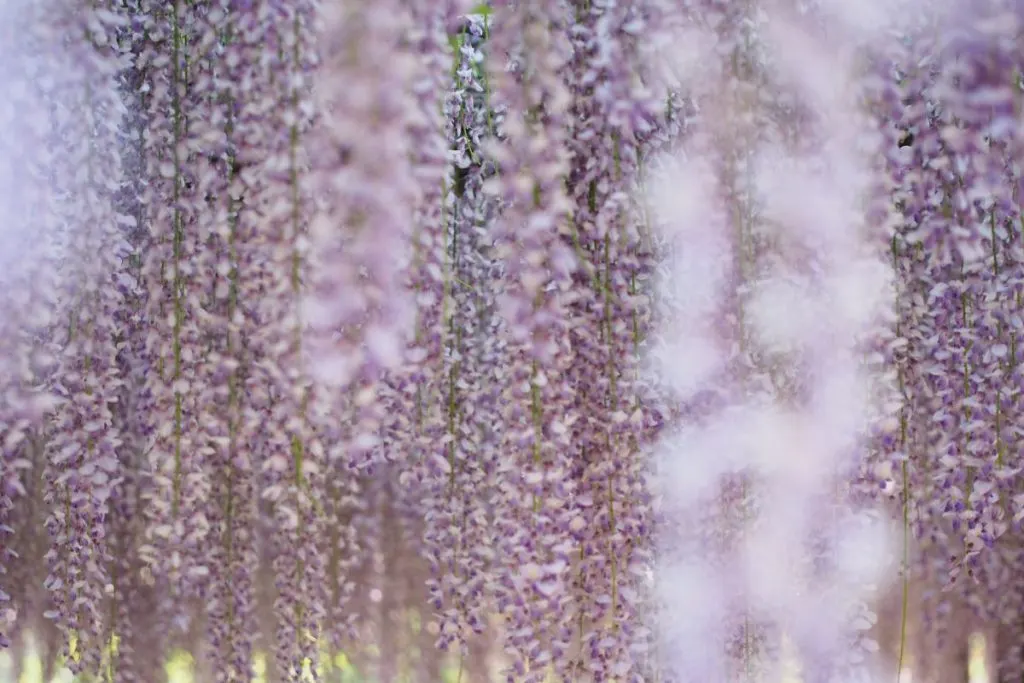
That would be all for today my dears! I hope you have learned a lot about hanging plants. Save this article and read it again if needed.
I also hope you don’t hesitate much now about purchasing your purple hanging plant.
The first step, in my logic, is to purchase a hanging basket. When you buy a basket, it will be silly for you to have it empty in your apartment and you will buy flowers for it soon! Hah! There you go!
Good luck with purchasing and planting your hanging purple flowers!

